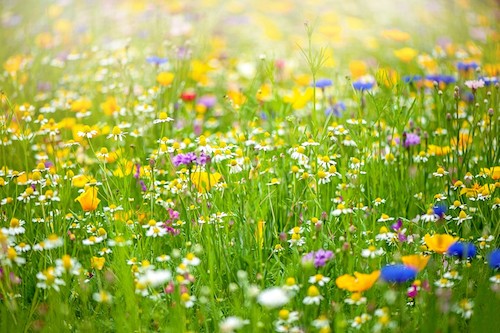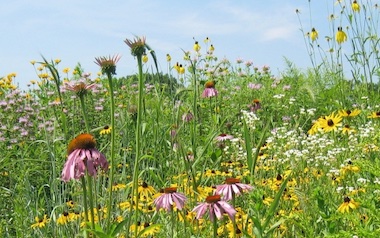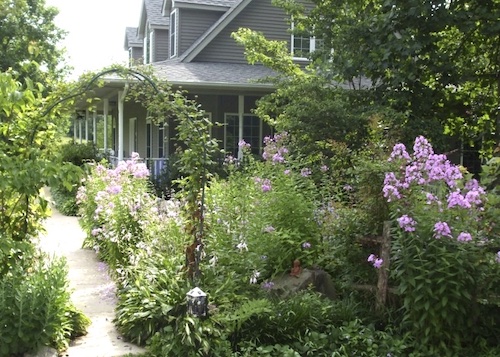Is a Meadow a Garden Choice to Welcome Pollinators?
by Ann M. Mason, Fairfax Master Gardener
 How many butterflies did you see last year? How about fireflies or bees? If you answer that it seems like it was less than in earlier years, you may want to consider what plants are in your yard.
How many butterflies did you see last year? How about fireflies or bees? If you answer that it seems like it was less than in earlier years, you may want to consider what plants are in your yard.
Horticultural experts are concerned about the measured reduction in pollinators globally. While considering a global ecosystem is beyond my mind’s ability, I am aware that the global ecosystem starts one yard at a time.
The number of pollinators visiting my yard seems to be less than five years ago. Digging into the research and expert advice, I realize that I face some choices — all of them include planting more native plants in larger clumps and choosing flowering plants to offer pollinators a continuum of blooms (nectar and pollen sources) throughout the growing season.

Pollinator on Monarda
Pollinators need four things to live successfully in an area: food, water, shelter and space. Many pollinators have distinct preferences for bloom shape, fragrance and bloom time. Fortunately, horticultural experts offer on-line databases to make plant selection easier for the homeowner. The U.S. Department of Agriculture suggests that garden have at least three different plant species planted in groups that provide food from the time pollinators emerge from winter hibernation, throughout the growing seasons and as they prepare for winter hibernation.
When choosing plants, University of Delaware expert Dr. Doug Tallamy strongly suggests including keystone plants in our yards. Keystone plants are known to support the widest variety of pollinator populations. Functioning much like the architectural keystone in a stone arch, keystone plants are the essential building block to support the entire ecosystem in your yard. Keystone perennial flowering plants in our Northern Virginia area, identified by the experts at Homegrown National Park, include Lanceleaf coreopsis (Coreopsis lanceolata), Common evening primrose (Oenothera biennis), Swamp sunflower (Helianthus angustifolius), a number of goldenrods (Solidago), Black-eyed Susan (Rudbeckia hirta), and Calico aster (Symphotrichum lateriflorum). See the Homegrown National Park link in our resources for other recommendations.

Overgrown landscape as a pollinator’s paradise
Fortunately, Xerces Society published a Habitat Assessment Guide for Pollinators in Yards, Gardens, and Parks, which allows gardeners to assess their current yards as input to future garden changes. After assessing the yard and determining changes are needed to attract more pollinators, the gardener has decisions to make. This includes what type of garden to create. Landscape architects offer many styles depending on your vision of formal, cottage, contemplation or wild. If your vision includes a wild style, a meadow might be your choice; but that choice is highly likely to be moderated by how neighboring property owners and your homeowner associations view a meadow.
Most experts characterize a meadow primarily as a diverse mix of native grasses (about 60 to 65 percent) with native wildflower species in a sunny location. In short, a grassland with wildflowers. For the grasses in our ecological zone, some experts recommend using mostly cool season grasses. Meadows attract a wide diversity of pollinators and wildlife and award the gardener with a less work once the meadow is established.

Dense established meadow to out-compete weeds
Establishing a perennial meadow is more than throwing some seeds on the ground and letting them ‘go native.’ Most experts instructing gardeners how to establish perennial meadows give the sobering forecast that it will take three to five years of work before the meadow thrives on its own. These gardeners have an adage: year one is for root growth; year two is to extend roots and begin to grow and spread above ground; and year three to fully establish. Each year the gardener will mow with occasional weeding, especially needed to remove any invasive species from gaining a foothold.
Generally, these are the basic steps in establishing a perennial meadow:
- Prepare the soil so it is weed-free. There are many ways to eliminate turfgrass or other plantings depending on the size of the area: digging to remove plants, solarization (cover soil with clear plastic), occultation (cover soil with dark or opaque plastic), herbicide application, tilling, planting a cover crop to smother existing roots, selective weeding, mulching and more. All experts highly recommend getting rid of all persistent invasive weeds, including the hard to kill/manage Canada thistle (Cirsium arvense).
- Plant perennial grasses along with annual and perennial wildflowers. The time to sow seeds depends upon the wildflower. Generally sowing seeds is recommended for fall or late winter or early spring. Planting time for plants is usually in the spring.
- Year 1 is a year of mowing to control weeds. Mow at 4 inches (10 cm), which experts claim will be above the desired plant height. Mow weeds to prevent seed head formation.
- In the spring of Year 2, mow any left-over vegetation before the growing season. Maintain vigilance to remove any weeds before they get a foot hold. The gardener can add more seeds or plantings of desired plants. Mow late in winter or early spring.
- In year 3 the perennial meadow should become established, and the gardener can enjoy the fruits of their labor.
- In each following year, meadow maintenance should consist of an annual mowing late in winter or early spring and seeding or plant plugging to fill in gaps and spot weeding as needed.
Words for watchfulness. In this part of the country, open spaces want to return to a forested state. Annual mowing should curb saplings. Using pesticides and herbicides can negatively impact pollinators.
Since a meadow can look wild and untamed, urban gardeners often maintain an intentional edging of turfgrass or other pathway materials. Sharing your meadow plans and communicating your progress with neighbors may help to bring them along to this intentional habitat garden. Adding signage with the species of plants, insects and wildlife in the meadow will allow friends and neighbors to look for certain species. Creating and sharing observation areas can create tranquil places for you and your neighbors to enjoy.
-
References
- Find Your Roots Tool, Pollinator Partnership
- Native Plant Resources, Wisconsin Horticulture Extension
- Native Plant Resources, Homegrown National Park
- Container Gardening with Keystones, Homegrown National Park
- Mid-Atlantic Native Meadows, Guidelines for Planning, Preparation, Design, Installation, and Maintenance, Xerces Society
- Habitat Assessment Guide for Pollinators in Yards, Gardens and Parks, Xerces Society